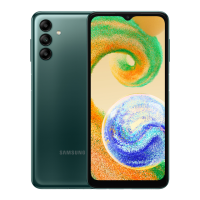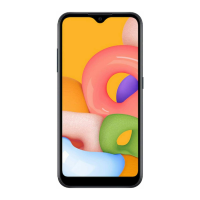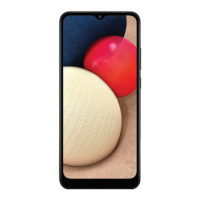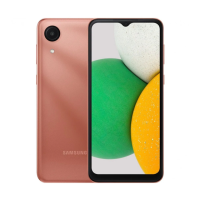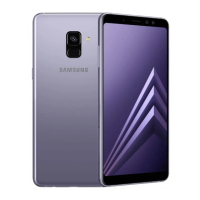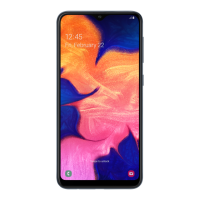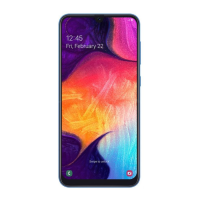Do you have a question about the Samsung Galaxy A04e and is the answer not in the manual?
Details the physical components and their locations on the device.
Instructions on how to charge the device's battery.
Information on inserting and managing SIM cards.
Details about using external memory cards.
Instructions for powering the device on and off.
Steps for setting up the device after first use or reset.
Guide to transferring data using the Smart Switch feature.
Explains how to interact with the device's touchscreen.
Information about locking and unlocking the device screen.
Information about the keyboard and text input.
Guide to downloading and removing applications.
Core functions for making and receiving calls.
Managing phone contacts and contact information.
Sending and receiving text messages.
Browsing the web and managing bookmarks.
Taking photos and recording videos.
Viewing and managing photos and videos.
Using two apps simultaneously on the screen.
Managing wellness, fitness, and health tracking.
Creating and managing notes with text, images, and voice.
Managing schedules and events.
Setting and managing reminders and to-do items.
Listening to FM radio stations.
Recording and playing voice memos.
Sharing files and media with others.
Overview of Google services like Chrome, Gmail, Maps, etc.
Managing Wi-Fi, Bluetooth, and other network connections.
Connecting to Wi-Fi networks and managing settings.
Pairing and using Bluetooth devices.
Reducing mobile data usage by limiting background activity.
Setting up the device as a Wi-Fi hotspot.
Adjusting volume, ringtones, and vibration settings.
Managing notification pop-ups, sounds, and Do Not Disturb.
Adjusting screen brightness, theme, font, and other display settings.
Changing wallpapers for Home and lock screens.
Customizing the device's locked screen appearance and behavior.
Managing security features like face recognition and Google Play Protect.
Managing app permissions and privacy settings.
Controlling location services and app access to location data.
Setting up emergency contacts, SOS messages, and alerts.
Managing accounts and backing up device data.
Backing up and restoring data using Samsung Cloud.
Accessing and configuring advanced device functionalities.
Monitoring device usage and setting parental controls.
Overview of battery, storage, memory, and security status.
Checking and managing device storage space.
Updating the device's operating system and firmware.
Customizing system settings and resetting the device.
Viewing device information, status, and legal details.
General safety guidelines and important usage information.
Information about items included with the device and accessories.
Explains causes and solutions for device overheating.
Advice on using the device in different environmental conditions.
Solutions for common device issues and errors.
Solutions for touchscreen malfunction or unresponsiveness.
How to resolve device freezes or critical errors.
Troubleshooting steps for call connection issues.
Steps to take if the battery is not charging correctly.
Troubleshooting camera app errors.
Troubleshooting Bluetooth connection and performance issues.
Importance of backups and what to do if data is lost.
| Panel type | LCD |
|---|---|
| Screen shape | Flat |
| Display diagonal | 6.5 \ |
| Display resolution | 1600 x 720 pixels |
| Rounded display corners | Yes |
| Display number of colors | 16 million colors |
| RAM capacity | 3 GB |
| Compatible memory cards | MicroSD (TransFlash) |
| Maximum memory card size | 1000 GB |
| Internal storage capacity | 32 GB |
| Processor cores | 8 |
| Processor family | - |
| Processor frequency | 1.8 GHz |
| Processor boost frequency | 2.3 GHz |
| 4G standard | LTE-TDD & LTE-FDD |
| 3G standards | WCDMA |
| SIM card type | NanoSIM |
| Wi-Fi standards | 802.11b, 802.11g, Wi-Fi 4 (802.11n) |
| Bluetooth version | 5.0 |
| 3G bands supported | 850, 900, 1900, 2100 MHz |
| 4G bands supported | 2100, 1900, 1800, 850, 2600, 900, 700, 2300, 2500 MHz |
| SIM card capability | Dual SIM |
| Mobile network generation | 4G |
| Rear camera type | Dual camera |
| Front camera type | Single camera |
| Front camera flash | No |
| Maximum frame rate | 30 fps |
| Rear camera aperture number | 2.2 |
| Video capture resolution (max) | 1920 x 1080 pixels |
| Rear camera resolution (numeric) | 13 MP |
| Front camera resolution (numeric) | 5 MP |
| Second rear camera aperture number | 2.4 |
| Second rear camera resolution (numeric) | 2 MP |
| Talk time (3G) | - h |
| Battery capacity | 5000 mAh |
| Color name | Black |
| Form factor | Bar |
| USB version | 2.0 |
| USB connector type | USB Type-C |
| Headphone connectivity | 3.5 mm |
| Platform | Android |
| Audio formats supported | MP3, M4A, 3GA, AAC, OGG, OGA, WAV, AMR, FLAC, MID, MIDI, XMF, MXMF, IMY, RTTTL, RTX, OTA |
| Video formats supported | MP4, M4V, 3GP, 3G2, AVI, FLV, MKV, WEBM |
| Subscription type | No subscription |
| Depth | 9.1 mm |
|---|---|
| Width | 75.9 mm |
| Height | 164.2 mm |
| Weight | 188 g |
